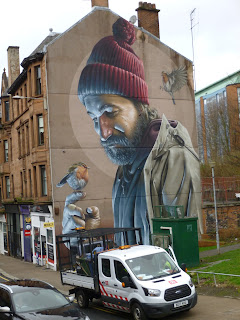I’ve always found camouflage fascinating. Many animal, plant, and insects adaptations are absolutely amazing. This is probably my favourite character from our Madagascar trip.
One of my first loves was
butterflies and moths, and as a child my room would hum at night with hawk
moths flying about sipping honey water and going about their business. Because of its name if nothing else, the Death’s-head hawk moth of Silence of the Lambs fame was a special favourite. It looks pretty obvious on someone's lips, but camouflages pretty well against tree bark.
 |
| Male in the top left box, females below the line and the bad tasting species they mimic next to the male |
And, of course, I loved the beautiful
swallowtail butterflies. At our family home in Cape Town, the long-suffering orange and lemon trees had to support large families of the citrus swallowtail caterpillars. But my favourite was the mocker swallowtail which required a more tropical climate. Here camouflage
takes the form of mimicry. One eminent entomologist described it as "the most interesting butterfly in the world". The females have multiple forms depending on the
surrounding environment. They often look nothing likes the handsome males but
quite like an unpalatable species that is common in the area – sometimes they
have multiple forms in the same place, each similar to a quite different unpalatable
model. It's interesting to speculate how that evolved. If they all started out looking like the males - and some of the females still do - then how did they become such good mimics?
Speaking of evolution, the process leading to camouflage development can be relatively
quick – some species of white moths in Britain have evolved to a smoky grey colour
since the industrial revolution. Maybe since the air has been cleaned up, they
will evolve back. (If climate change gives them long enough.)
Camouflage also finds its place in the animal kingdom where
predators and prey alike would rather not be spotted. Hmm. Unintentional pun,
because I want to mention the leopard. The spots are supposed to make them hard to
see and beautiful when you do. This was really brought home to me when I was
in the bush with two friends. We stopped at a small water hole close to the road and started admiring various water birds. To the left of the pool was a slope with
greenish plants which were sporting yellowish flowers. It seemed odd that
although the plants stretched along the bank only one area near the water had
the flowers. Still, we were concentrating on a Goliath heron so we didn't pay much attention. Then the "flowers" got up, walked towards the road, and gently called a cub
out of the bush just to the left of us. The mother leopard had been drinking no more than 100 metres away.
 |
| Seriously. Would you see the snow leopard of it wasn't raising dust? |
Apart from just enjoying the intricacy and beauty of nature, I'm fascinated by how camouflage works, and that links to my interests in image processing. Why didn’t I see that leopard?
The issue isn’t with our eyes. They behave pretty much like
an ordinary sensor in your digital camera. We have red, green and blue cones in the eye that
are sensitive to the wavelengths of those colours, and then we have rods which give us brightness
when the light isn’t good enough for colour vision. The eye's lens focuses the light on these individual
sensors in the retina, and each sends a signal to the brain for that particular ‘pixel’. That’s
pretty much how a digital sensor works too. The interesting part comes after
that in the brain. That’s when we do – or do not – see
what’s out there.
We don’t really know how the brain does this vision processing. It’s
very different from what computers do and that’s why computer vision is a large, difficult area of study with lots of problems to still to solve. Computers find it really hard to do what our brains do. Or even what a mouse's brain does for that matter. We do know a few things. Movement is a giveaway.
We don’t analyse the background much – we sort of get a general impression of it and
then set it aside, but we react at once if something moves against it. That’s
pretty easy for computers too. All predators know this. If a cat is stalking, it
freezes at once if the prey glances in its direction. We also know that
generally we see what we expect to
see. So when the prey glances in the direction of the frozen stalking predator, it
sees more background. Similarly the bird spotting a female swallowtail
mimic, sees the unpalatable species. Recent developments in deep learning applied
to computer vision have started exhibiting similar behaviour.
 |
| Hyperstealth |
A Canadian inventor, Guy Kramer, has started applying these
sorts of algorithmic techniques to camouflage clothing for armies (and spin-offs for fashion) with a company called Hyperstealth. Obviously, he keeps how he does
his designs very close to his chest, but it’s clear that he uses the
mathematical idea of fractals and also the way images pixelate. The former is
probably because the real world isn’t ‘smooth’ so fractals are what our brains
expect, the latter may have more to do with the way digital sensors work since
much surveillance now is done by sensors and computers. It seems to work. Or at
least the armies that spend millions of dollars with his company believe it
does. Of course, a little thought is needed. The Afghan army chose the forest camouflage when only 10% of their country is forested. Oh well, it's only money.
 |
| Is this real??? |
Not satisfied with that, Kramer is after a Harry Potteresque cloak of
invisibility. Miniature cameras on the back display the background on the front? That’s not entirely science
fiction. Still, he’s only working on prototypes. We think. But if he comes up with a
production model, the pentagon and other country's equivalents will be after lots more budget. Watch
this space. And don’t only watch your back...







































































